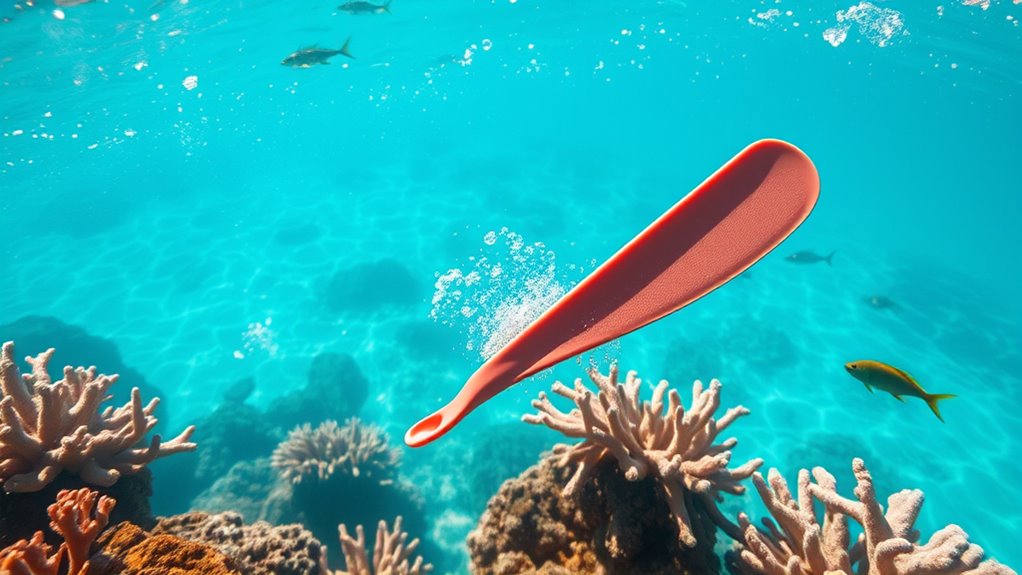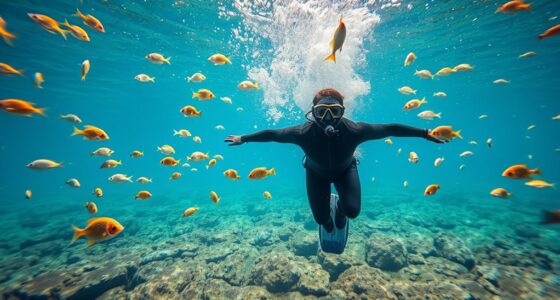To avoid damaging reefs, focus on using gentle, controlled fin kicks like vertical or choomer kicks, which reduce contact with delicate corals. Practice relaxed movements that require less force, and keep your fins close to your body for better control. Avoid powerful flutter or frog kicks that can scuff or harm reef structures. Adopting these techniques helps protect marine ecosystems, and you’ll discover more smart tips for eco-friendly diving as you continue.
Key Takeaways
- Use gentle, slow fin kicks like sculling or modified flutter to minimize contact with corals.
- Avoid forceful or large kicks that can scuff or damage fragile reef structures.
- Maintain proper buoyancy to prevent accidental contact with the reef during finning.
- Choose fins with soft, flexible blades designed to reduce reef contact and environmental impact.
- Practice mindful finning techniques to promote sustainable diving and protect marine ecosystems.

If you’re passionate about diving or snorkeling without harming delicate coral reefs, the new coral-friendly fin kicks are a game-changer. Traditional fins can unintentionally cause damage to fragile marine ecosystems, especially when divers kick or scuff the reef with force or improper technique. These new fins are designed with eco-conscious materials and innovative shapes that minimize contact with the reef, making marine conservation easier for everyone. By adopting these fins, you’re actively contributing to the protection of coral reefs, ensuring they remain vibrant and resilient for future generations.
Embrace coral-friendly fins to protect reefs and enhance your eco-conscious diving experience.
Diver education plays a vital role here. Many divers aren’t fully aware of how their movements can impact the reef. Proper training emphasizes gentle finning techniques and awareness of your surroundings. When you learn to use coral-friendly fins correctly, you reduce the risk of accidental contact and reef damage. These fins often feature softer blades or specialized designs that require less effort and force, helping you maintain buoyancy and control without kicking aggressively. This not only preserves the reef but also enhances your overall diving experience, making it more relaxed and mindful.
Using coral-friendly fins also aligns with global efforts to promote marine conservation. Many dive operators and organizations now encourage or even mandate the use of eco-friendly gear to protect marine life. By choosing these fins, you send a clear message that you prioritize the health of the ocean. It’s a simple yet impactful step that complements broader conservation initiatives. Your conscious gear choices inspire others to follow suit, creating a ripple effect of responsible diving practices.
Furthermore, these fins often incorporate durable, non-toxic materials that don’t leach harmful chemicals into the water. This aspect supports the overall health of marine ecosystems, ensuring that your diving activities don’t inadvertently contribute to pollution. Proper diver education includes understanding the importance of sustainable gear and responsible diving habits. When you combine effective technique with eco-friendly equipment, you maximize your positive impact and help preserve the beauty of coral reefs. Additionally, understanding foraging range principles can help divers appreciate the importance of minimizing their environmental footprint and supporting healthy marine populations.
Frequently Asked Questions
Are Coral-Friendly Fin Kicks Suitable for All Diving Skill Levels?
You might wonder if coral-friendly fin kicks suit all diving skill levels. These kicks improve diving safety by reducing reef damage and are generally easy to learn, making them suitable for beginners. However, your comfort and skill with equipment considerations matter. If you’re a more experienced diver, you might prefer different techniques. Overall, coral-friendly fin kicks are accessible for most divers, promoting safe, eco-conscious diving practices.
How Do Coral-Friendly Fin Kicks Compare in Speed and Efficiency?
Like a gentle breeze over calm waters, coral-friendly fin kicks glide smoothly, balancing speed and efficiency. You’ll find that their fin design allows for effective propulsion without stirring the reef, though they may be slightly less swift than traditional fins. Suit compatibility varies, but generally, these kicks excel in conserving energy and protecting delicate coral. With practice, you’ll discover they offer a harmonious blend of gentle power and eco-conscious performance.
Can Coral-Friendly Fin Kicks Be Used in Strong Currents?
In strong currents, coral-friendly fin kicks may face some limitations, but you can adapt. The current limitations mean you might need to adjust your equipment or technique, like using more powerful or differently shaped fins for better propulsion. While these kicks are designed to minimize reef damage, don’t forget to make equipment adjustments to improve efficiency and maintain control, especially in challenging conditions. Practice helps you master these adaptations for safer, more effective diving.
Do Coral-Friendly Fin Kicks Require Special Equipment or Training?
They say “practice makes perfect,” and that applies to coral-friendly fin kicks too. You don’t need special equipment, just proper technique and awareness to protect reef preservation. With some training, you’ll learn how to minimize contact and avoid damaging delicate corals. Focusing on your movements is key—no fancy gear required. Just stay mindful of your fins and your surroundings to help keep reefs healthy and vibrant.
How Long Does It Take to Master Coral-Friendly Fin Kicks?
Mastering coral-friendly fin kicks varies depending on your diving experience, but generally, it takes a few dives to get comfortable with the proper technique. Focus on smooth, controlled fin kick techniques that minimize prop wash to protect reef conservation. With practice, you’ll develop efficient movement that reduces damage, making your dives more sustainable. Patience and mindful practice are key to mastering these skills and contributing positively to reef preservation.
Conclusion
By choosing coral-friendly fin kicks, you protect the reef like a gentle guardian. Imagine your movements as a soft breeze, gliding over delicate coral without a trace of harm. Every kick becomes a mindful act, preserving the vibrant underwater world for future generations. So, next time you dive, remember—your gentle touch can make all the difference, just like a whisper of wind that keeps the reef alive and thriving. Dive responsibly, and protect these precious ecosystems.










